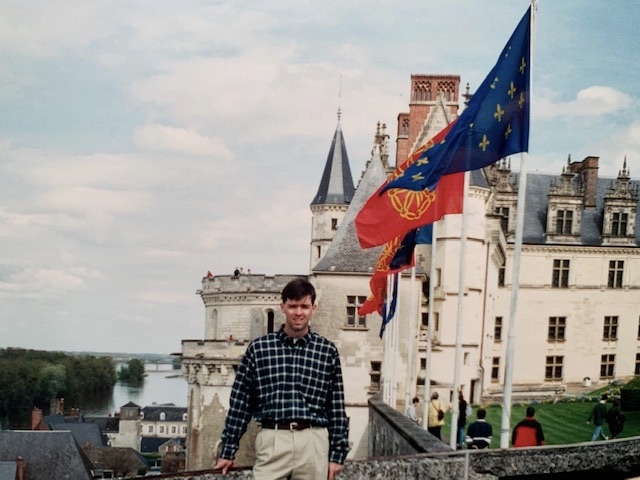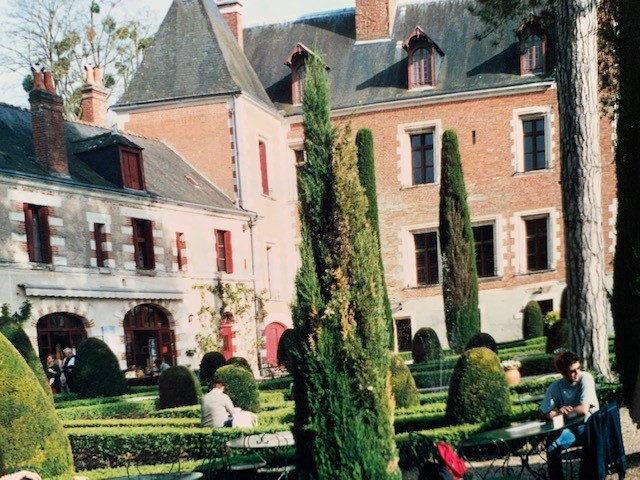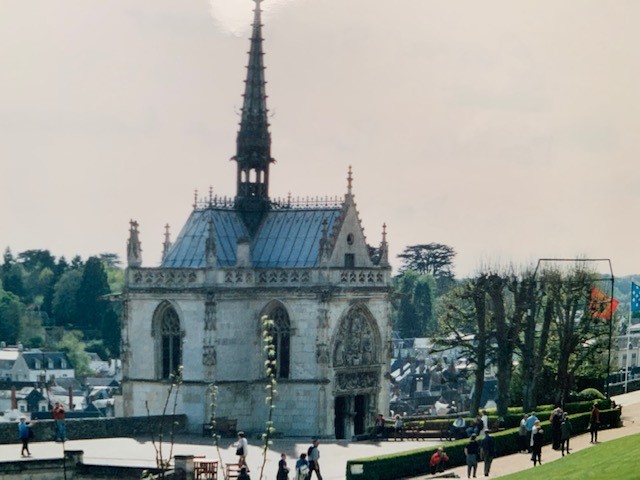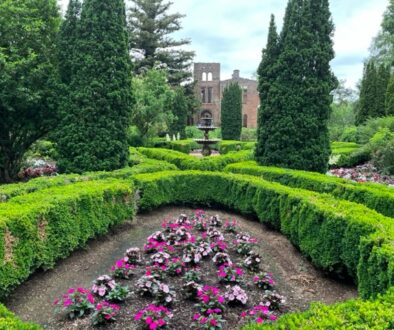An Afternoon with Leonardo da Vinci

Amboise, France
April 18, 2000
The picturesque Château d’Amboise rises majestically from a promontory above the Loire and across from L’île d’Or. The strategic merit of the site is obvious, and fortifications have been built here since at least the tenth century.
What we see now are the remnants or restorations of its Italianate incarnation begun five hundred years later. That architectural influence was part of the booty Charles VIII brought to France after his conquests in Italy. And, from his Sicilian realm, he brought Pacello de Mercogliano, a Neopolitan religious who designed the embroidered gardens of fine flowers, sculpted shrubs, and flowing fountains.
The Loire Valley was fast becoming the playground and hunting grounds of the Valois kings. For the better part of a couple centuries, Amboise housed their courtiers, their intrigues, and their guests. Mary Stuart, Queen of Scots, would spend most of her early years here, with the court of Henri II. Leonardo da Vinci spent his three final ones next door, as guest of François I.

The shift began after Charles VII arrived in Bourges when hiding from the English during the Hundred Years’ War. Chinon became his preferred refuge, till Joan of Arc cleared a path for him to reclaim his contested throne. His son Louis XI chose Amboise as residence for his queen, Charlotte of Savoie, who there bore the future Charles VIII.
As Chenonceau is forever associated with Diane of Poitiers and Catherine de Medici, Amboise would be linked to Charles VIII and Anne of Brittany. Their castle is interesting, tho’ far less appealing than the “Ladies Château” we visited this morning.
Brick covers the walls of the main hall, thru which we were channeled under low ribbed vaults, toward a couple off-center fireplaces topped with stone pediments bearing Brittany ermine and regal fleur-de-lis. Those emblems littered each supporting column, and interesting stone corbels adorned the base of each arch.
The King accelerated architectural enhancements, adding two ceremonial loggia, the Chapelle Saint-Hubert, and the cavalry towers by which the château was then easily accessed, and is now so widely recognized. Throughout the interior are his flaming sword emblem and Anne’s ancestral arms.
By all accounts, both royals were rather homely, and their home cast a pall on both. At Amboise their marriage produced seven pregnancies, three of which ended stillborn, four in infant death. Charles paid his own debt to nature in this cursed castle, after banging his head on a low lintel en route to the handball court. Passing under it ourselves, we made sure to duck, then quickly escaped this haunted house.
Anne did as well, moving downstream to Blois with her new husband, Louis XII, and ultimately leaving Amboise to his successor, François I. The rooms and furnishings of the modern castle reflect many centuries, and can clash or be disorienting to those trying to follow the historical flow. But as we ventured around the castle grounds, high above the river, the Renaissance influence on the new regal patron of art, literature, and science was apparent.
François brought their embodiment, Leonardo da Vinci, to Amboise to enrich his court’s cultural reputation. Leonardo made his last home at the adjacent Château de Clos Lucé, where Charles VIII had built a chapel for Anne de Bretagne to mourn their dead children.

Raphael and Michelangelo were ascendant, and François ruled Milan, when Leonardo hopped on a mule and crossed the Alps in his 65th year. He left his young rivals in Italy to spend his old age in France.
With him he brought a couple pupils and a few masterpieces. By this arduous journey, the Mona Lisa, the Virgin and Child, and St. John the Baptist came to France, and the Louvre, where we plan to see each of them next week.
We visited the room where Leonardo wrote his will, and in which he slept the last three years of his life. Nearby we found the bedchamber of Marguerite de Navarre, sister to the king and a personified confluence of Reformation and Renaissance. Her chambre is furnished in 16th century style, overseen by a portrait of the princess, gazing intently at her guests from one of the display cabinets.
Down the hall we again came upon Anne de Bretagne. In her oratory are four frescoes, including an Annunciation from the brushes of Leonardo’s disciplines. Above the door, a Virgo Lucis graces the entrance, and gives a name to this small château.
An underground passage once connected Le Clos Lucé to Château d’Amboise, enabling easy communication between an aspiring Renaissance King and the quintessential Renaissance Man. It has since sealed, so we couldn’t traverse it.
But we did follow Leonardo’s last steps, or at least those of his pall bearers, to the Chapelle Saint-Hubert, in the gardens surrounding the main château. This pretty, intricate chapel houses the great man’s crypt, and little else.

Yet it is a gem in its own right. Parapets, gargoyles, pinnacles, and spire adorn the sturdy exterior. The exquisite little edifice stands at the edge of the great wall separating the château grounds from the surrounding town.
Its architecture typifies the changing styles and aspirations of the age. The façade tells the story of St Hubert, and throughout the small structure Renaissance touches enliven Gothic solemnity. Stained glass, marble ribs, carved quatrefoils, and trefoil arches glorify the interior. A marble plaque and copper portrait mark Leonardo’s remains, all surrounded by decorative fleur-de-lis floor tiles.
As we left the tomb and stood outside, we realized that this little chapel is sufficient reason to visit the Château d’Amboise. But the moment was unfortunately diminished by a loud American woman yelling across the courtyard about the poor fit of her tight underwear. One can imagine how proud we felt as we stepped slowly away to avoid any implicit association with our embarrassing countrymen. Lafayette we are here!
We thought this an opportune time to leave the château and wander the town. While the fortified castle and Clos Lucé are the obvious attractions in this small village, the rest is not without its charms. They are not necessarily distinctive, but we are noticing that even everyday features of normal French life hold considerable appeal.
Beneath the imposing castle walls, façades of stone and frames of wood front an array of buzzing boulangeries, busy bookshops, and casual cafés along the bustling sidewalks of narrow medieval streets.
The town feels much larger than it is. This is no doubt partially because of tourists. But we hear almost no languages other than French, and few seem (or claim) to understand English. Pedestrian activity and al fresco seating offer energy not often apparent along streets of American cities of comparable size.
We joined first the pedestrians, then the sitters, grabbing a quick bite and a relaxing drink at one of many sidewalk cafés along Rue Chaptal. Then, under the fading light of a full day, we returned to our trusty Renault, which brought us twenty minutes upstream, back to our own welcoming château.
JD




A Simple Shack – JD Breen's Diary
July 1, 2020 @ 12:06 pm
[…] usually kept royal residence at Amboise or Blois. He built Chambord as a hunting lodge, but never saw it finished. He rarely saw it […]